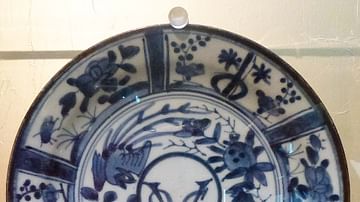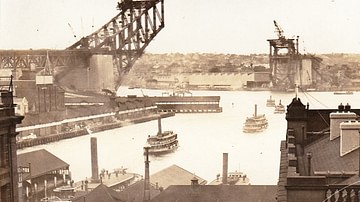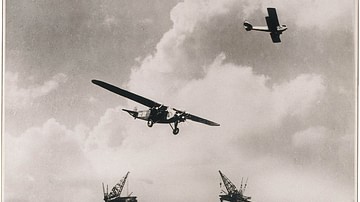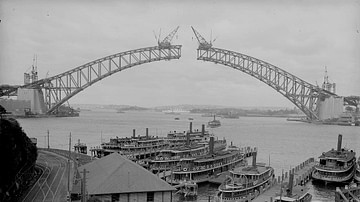The Sydney Harbour Bridge – affectionately known as The Coathanger by Australians – was opened to great fanfare and a touch of scandal on 19 March 1932 and was the longest steel arch bridge in the world at the time, with a span of 503 metres (1,650 ft) and standing at 134 metres (440 ft) above Sydney harbour.

Before the bridge was constructed, there were two Sydneys – the north side, with a population of around 300,000, and the south side and central business district, with 600,000 people. A regular and reliable ferry service took passengers across the harbour, carrying 13 million annually by 1908. There was also a land route from the south to the north shore, which was a time-consuming journey known as the 'five bridges' – horses and cars crossed a series of bridges over the Parramatta River, a detour that added 20-30 kilometres (12-19 mi) to the trip.
As Sydney's population grew and up to 75 ferries crisscrossed the harbour, often in dangerous and foggy conditions, the need for a bridge to connect the northern and southern shores gained momentum. One extraordinary man, Dr John Job Crew Bradfield (1867-1943), envisioned a structure that would unite Sydney – a minimalist, sweeping steel structure embodying modernist design aesthetics, breaking free from the city's convict-era agrarian roots.
Early Designs
Charles Darwin's grandfather, Dr Erasmus Darwin (1731-1802), was inspired by reports of the NSW colony and mentioned the vision of a 'proud arch' in his poem Visit of Hope to Sydney Cove, near Botany Bay, published in 1789. However, the first person to seriously propose a harbour bridge was the emancipated convict and New South Wales (NSW) government architect Francis Greenway (1777-1837). In an 1815 report to Governor Macquarie (1762-1824), Greenway raised the idea and also wrote to the editor of The Australian newspaper, which published Greenway's letter on 28 April 1825:
Thus in the event of the Bridge being thrown across from Dawes Battery to the North Shore, a town would be built on that shore, and would have formed with these buildings a grand whole, that would have indeed surprised anyone entering the harbour; and would have given an idea of strength and magnificence that would have reflected credit and glory on the colony and the Mother Country.
(The Australian, Letter to the Editor)
Greenway's vision was never adopted. The engineering skills and steel technology to span the harbour were not yet available, and the NSW colony was focused on agricultural production and settlement.
The next proposal was put forward in 1857 when English-trained engineer Peter Henderson designed a bridge from Dawes Battery (now Dawes Point on the south side) to Milsons Point. Henderson had worked with Isambard Kingdom Brunel (1806-1859), the renowned and groundbreaking 19th-century engineer who designed London's Paddington Station, the Great Western Railway linking London with the west of England and South Wales, and various steamships.

Henderson's sketch for a cast iron bridge supported by two pylons on either side of the harbour is the oldest existing practical plan. The population and economic activity on the northside in 1857 were not significant enough to convince the colonial government. It is also likely that engineering knowledge at the time would have resulted in a bridge that may have fallen into the harbour. Cast or wrought iron, which is not as strong as steel, might not have been capable of withstanding the stresses of a large span in a harbour with strong tides and a city frequently buffeted by high winds.
By the turn of the century, north shore residents had formed the Sydney and North Shore Junction League, championing a bridge inspired by the vision of Sir Henry Parkes (1815-1896), a local politician and five-time premier of NSW. Parkes had called for a bridge to improve transportation and promote urban development. This resulted in Minister for Works E. W. O'Sullivan (1846-1910), announcing a design competition in January 1900. Submissions were received from local and international engineers.
Competition Controversy
The competition – the first of four competitions run between 1900 and 1924 – became mired in controversy. Australian engineer and naval architect Norman Selfe (1839-1922) was awarded second prize for his suspension bridge proposal and £500, but there was public outcry that a local engineer had not been selected as the winner. The winning design was by G. E. W. Cruttwell (1857-1933), an English engineer, but it was considered too costly, and the advisory board questioned the structural aspects of Cruttwell's design.
Norman Selfe won the second 1903 competition with a two-lane steel cantilever design but declared his annoyance that the NSW government caused companies and individuals to waste time and money on what he called the Sydney Bridge Guessing Competition. Selfe's design was the victim of a change in government and an economic slowdown.
A Man with a Grand Vision
By this stage, John Job Crew Bradfield was accumulating sound engineering knowledge. Born in Sandgate, Queensland, in 1867, his family had migrated to Australia from England in 1857. Bradfield flourished at school and received a scholarship to study engineering at the University of Sydney, where he graduated with first-class honours and won the university medal in 1889. After marrying, he settled in Gordon on the upper North Shore and began work in the government's Engineering Drawing Office, where he soon became involved with checking calculations on the Pyrmont and Glebe Island electric swing bridges. Bradfield, who some sources suggest had already started imagining a harbour bridge, kept up-to-date with bridge collapses overseas. In 1907, the Quebec Bridge in Canada collapsed, killing 85 people. It was a steel cantilever bridge that had replaced a wrought iron structure.
In 1914, Bradfield was sent on a short overseas trip to study long-span bridges and saw the construction of New York's Hell Gate steel single-arch bridge, which sits at the north end of the East River. This bridge opened in March 1917 and was designed by Gustav Lindenthal (1850-1935), an Austrian-born American engineer.
John Bradfield was a canny lobbyist and rallied public support for the bridge, but the project was consistently shelved due to economic difficulties following the 1890s depression and the First World War (1914-1918). Political support also waxed and waned. In April 1920, John Storey (1869-1921) became premier of NSW and strongly supported the bridge project. However, Storey died in October 1921, and James Dooley (1877-1950) took over. Although Dooley was not against the bridge, he was more interested in an electric underground transportation system between Milsons Point and Circular Quay, an idea proposed by the Kearney High Speed Railway Company of England. Bradfield discovered that some parliamentary caucus members were strong advocates of the tube concept, despite it only being tested on models.

Bradfield was set overseas again by the NSW government in March 1922, spending a short time in Chicago at the McClintic Marshall Company discussing suspension and cantilever bridges as well as steel arch bridges. James Dooley lost the election in March 1922, and the new NSW government under the premiership of Sir George Fuller (1861-1940) recalled Bradfield, ordering his return to Sydney and the cancelling of the harbour bridge project. His secretary, Kathleen Butler (1891-1972), who managed the international tender process, warned Bradfield, and he quickly left for London, ignoring the premier's recall.
Back home, the NSW parliament passed the Sydney Harbour Bridge Act in November 1922. Despite opposition, the Fuller Government recognised the need to ease traffic congestion in a city with over one million people, with one-third living on the north side. Bradfield had been doing his research and concluded that an arch bridge would cost £400,000 less than a cantilever design.
In 1923, tenders were invited for both a cantilever and an arch bridge, and Bradfield, who had been appointed chief engineer for the Sydney Harbour Bridge and Metropolitan Railway Construction in 1912, was to oversee the design and construction processes. However, he had to wait another eight years before his vision of a bridge spanning Sydney harbour was completed.
Tenders closed on 16 January 1924, and 20 tenders were received from six companies. The tender document stipulated that, as much as possible, materials should be sourced locally. Loans for the construction were secured from England and would take 55 years to pay off. Bradfield sifted through the designs. The English Electric Company of Australia (EEC) prided itself on being the only Australian tender, but Bradfield rejected their suspension bridge designs, also stating that the company did not have the necessary experience.
Goninan & Co's £10 million suspension bridge was also rejected, as were McClintic Marshall Company designs, which Bradfield felt lacked grace. Gustav Lindenthal prepared the tender document for McClintic Marshall and claimed he did not know the tender specifications had been rewritten to include an arch. He later said the winning design was remarkably similar to the Hell Gate Bridge in New York.
Scottish firm Sir William Arrol & Co submitted a design that would use new steel developed during the war by the British Admiralty. Australian architect and engineer Francis Ernest Stowe (d. 1936) developed a futuristic design for the time period – a three-span bridge supported by a central 152-metre (498 ft) high tower on Goat Island that would function as a war memorial.

It was a fierce competition, but the British engineering firm Dorman, Long & Co of Middlesbrough was the winner, and Bradfield and his team recommended design A3 from their tender – a two-hinged steel arch with four pylons. Dorman, Long & Co also submitted designs without pylons that would have been less costly, but Bradfield envisaged a grand statement. Granite from quarries at Moruya, south of Sydney, would be used, as well as some Australian steel, although Dorman, Long & Co would produce roughly 52, 800 tonnes of steel and ship it to Australia.
The Construction Process
To mark the commencement of construction, the first clod of earth was shovelled by Minister for Public Works and Railways Richard Thomas Ball (1857-1937) on 28 July 1923, at 3:00 p.m. on the north side. The Sydney Harbour Bridge Act gave the NSW government the power to compulsorily acquire and demolish homes in the path of the bridge approaches. 802 homes and businesses were demolished in areas such as Milsons Point and The Rocks. Not all families were compensated and the upheaval caused significant financial and emotional distress.

John Bradfield would be responsible for connecting the rail, tram, and roadways to the bridge, while the Scottish engineer Lawrence Ennis (1871-1938), sent by Dorman, Long & Co in 1925, was the director of construction. He would remain in Australia until the bridge was completed. Ennis admitted that the Sydney Harbour Bridge was "the most difficult construction I have encountered in my 40 years in bridge work" (Lalor, 156).
Dorman, Long & Co set up bridge fabrication workshops on the northern side of the harbour, which produced steel trusses, girders, and panels as well as the six million rivets that would be hand-driven and join the steel plates and trusses. Stonemasons were employed from Scotland as Australia did not have the expertise to work with granite on the large scale necessary for the four bridge pylons.
It was a groundbreaking project involving innovative construction methods. Dorman, Long & Co built electric creeper cranes specifically for the job, weighing 575 tonnes each. They were novel for the time period because they could climb the arch as it was constructed and eliminated the need for expensive scaffolding over a busy harbour. The cranes could lift steel up to 122 tonnes and fit sections into place.

Another novel construction method was the building of the arch, which was constructed in two halves from both sides of the harbour. By June 1928, the onsite workshops had pre-assembled trusses and plates and transported them to the construction site by barge. The creeper cranes then lifted the components, and the arch was constructed progressively outward, meeting in the middle on 19 August 1930, at 10:00 pm. The arches were stabilised by 128 steel cables wound across the top of the half-completed pylons and anchored into deep tunnels excavated on the north and south shorelines. Once in place, the arches were self-supporting, a keystone pin held them in place, and the cables were removed. This technique had been used in 1916 for the Hell Gate Bridge and the Victoria Falls Bridge over the Zambesi River, but the Sydney Harbour Bridge is 50 times heavier. Thermal expansion meant that the arch could lift 18 cm (7.08 in) on a hot Sydney day, so the cooler temperature of the night provided more stable conditions for the arches to meet.
Dangerous Work
Bridge construction took eight years, but during the Great Depression, when the employment rate in Australia was as high as 21% by mid-1930, it provided jobs for 1,400 labourers. The bridge earned the name 'the Iron Lung' because it saved many families from needing the 'susso' (sustenance payment or welfare relief).

Modern occupational health and safety regulations were not in place in the 1920s and 1930s. 16 men were killed during the construction, often slipping off steel girders and plummeting into the harbour below. Vincent Kelly was lucky. In October 1930, he overbalanced while riveting and tumbled backwards, somersaulting through the air and entering the water feet first – a 'human spear' position that saved his life.

The 1,400 labourers were riveters, riggers, steel constructors, boilermakers, and painters. A 'tin hare' was someone who assembled and guided steel into position while a 'rivet cooker' threw red-hot rivets that were caught in a bucket and hammered into place. John Bradfield selected the paint for the bridge, known as Sydney Harbour Bridge Grey, and 272,000 litres (71,854 gal) of paint were used. Australian actor Paul Hogan (b. 1939) was a bridge painter, but much later in the 1970s.
A Boy, a Captain & Two Horses
Sydney's iconic bridge was opened on 19 March 1932. The premier was Jack Lang (1876-1975), who was known as 'The Big Fella' due to his 193-centimetre (6'3") height and imposing presence. Lang was a staunch left-wing progressive and a champion of the working-class Australian. The opening ceremony was austere due to the economic restraints of the time, and controversially, Lang did not invite King George V of Great Britain (r. 1910-1936) and also suspended interest payments to British banks and bondholders due to the global financial crisis.
Lang was a great supporter of the bridge, viewing it as a symbol of progress and the 'people's bridge,' but the ribbon-cutting ceremony was scandalously interrupted by a member of the fascist, anti-Lang New Guard (a right-wing monarchist group). Irish-born Francis de Groot (1888-1969), wearing his World War I military uniform, rode a borrowed horse and sliced through the ceremonial ribbon with an antique sword, legally opening the bridge. De Groot was taken away by police and fined £5.00, and the Cinesound film of the fiasco, which later screened in cinemas, was seized by police officers.

In the 750,000-strong crowd that day was nine-year-old Lennie Gwyther (1922-1992) from Leongatha in Victoria and his horse, Ginger Mick. Lennie was so fascinated by the engineering marvel of the Sydney Harbour Bridge that he wanted to see it for himself. He set off on his own in February 1932 to make the 1,000-kilometre (621 mi) journey. By the time he arrived in Sydney on 8 March 1932, Lennie was a celebrity and was invited to join the opening ceremony along with Ginger Mick.
The Bradfield/Freeman Dispute
Although Australia recognises John Bradfield as the 'father' of the bridge, there has long been controversy, with some suggesting that the design of the bridge, specifically the arch, was not Bradfield's, even though he prepared the tender specifications and even sketched a steel arch bridge in his 1924 doctoral thesis, which was submitted before tenders closed. Undoubtedly, he drew inspiration from his overseas study trips, particularly from the Hell Gate Bridge design.
A bitter public spat broke out between Bradfield and the English structural engineer Ralph Freeman (1880-1950). Freeman worked for Dorman, Long & Co and claimed he had conceived of an arch bridge design at least two years before tenders closed. Freeman first met Bradfield in 1924 and was responsible for the final drawings. Freeman's arch was the design chosen from the A3 tender submitted by Dorman, Long & Co, and he also made significant changes to the design, mainly to do with the number of panels in the main arch trusses and the approaches to the bridge.

A series of increasingly fiery letters were exchanged between the two, and Dorman, Long & Co threatened legal action against the NSW government if a plaque on the bridge named Bradfield as the designer.
Australian historian Julia Horne concluded that Bradfield envisioned the bridge's initial design and meticulously supervised every aspect of its construction. Freeman's role in ensuring the detailed structural and engineering specifications was important, but it was John Bradfield's vision of a modern Sydney with electrified railways and a bridge that could cope with, as he predicted in 1917, a population of over 2.2 million in 1950, that delivered The Coathanger to the people of Sydney.
The total cost of the Sydney Harbour Bridge construction, including approaches, land acquisition, and interest on loans, was approximately £10 million.










